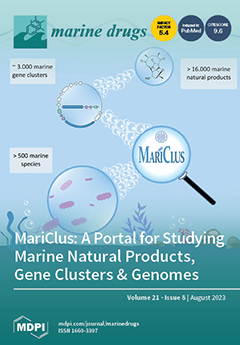To explore the steroidal constituents of the soft coral
Lobophytum sp. at the coast of Xuwen County, Guangdong Province, China, a chemical investigation of the above-mentioned soft coral was carried out. After repeated column chromatography over silica gel, Sephadex LH-20, and reversed-phase HPLC,
[...] Read more.
To explore the steroidal constituents of the soft coral
Lobophytum sp. at the coast of Xuwen County, Guangdong Province, China, a chemical investigation of the above-mentioned soft coral was carried out. After repeated column chromatography over silica gel, Sephadex LH-20, and reversed-phase HPLC, six new steroids, namely lobosteroids A–F (
1–
6), along with four known compounds
7–
10, were obtained. Their structures were determined by extensive spectroscopic analysis and comparison with the spectral data reported in the literature. Among them, the absolute configuration of
1 was determined by X-ray diffraction analysis using Cu K
α radiation. These steroids were characterized by either the presence of an
α,
β-
α′,
β′-unsaturated carbonyl, or an
α,
β-unsaturated carbonyl moiety in ring A, or the existence of a 5
α,8
α-epidioxy system in ring B, as well as diverse oxidation of side chains. The antibacterial bioassays showed that all isolated steroids exhibited significant inhibitory activities against the fish pathogenic bacteria
Streptococcus parauberis FP KSP28,
Phoyobacterium damselae FP2244, and
Streptococcus parauberis SPOF3K, with IC
90 values ranging from 0.1 to 11.0 µM. Meanwhile, compounds
2 and
6–
10 displayed potent inhibitory effects against the vancomycin-resistant
Enterococcus faecium bacterium G7 with IC
90 values ranging from 4.4 to 18.3 µM. Therefore, ten highly oxidized steroids with strong antibacterial activities were isolated from the Chinese soft coral
Lobophytum sp., which could be developed as new chemotypes of antibacterial drug leads.
Full article
 to open them.
to open them.





